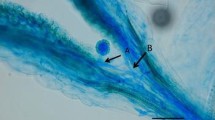Abstract
The observation that both compatible and incompatible pollen tubes grow at identical speeds on the stigma in many plants with ‘gametophytically controlled’ self-incompatibility (SI) systems has, in Petunia, been extended to cover all other facets of pollen behaviour on this tissue. On entry into the stylar transmitting tissue both types of tubes accelerate, but the compatible achieve a higher terminal velocity than do the incompatible, which eventually slow and stop. Grafting experiments show that the top 1 mm of the stylar tissue can play an important rôle in determining the future development of the pollen tube. Following mixed pollinations, proportionally too many ‘compatible’ pollen tubes reach the ovary than would be expected from the results of ‘pure’ compatible and incompatible pollinations indicating that incompatible pollen in some way helps ‘prime’ the style for growth of compatible pollen tubes. This data is considered in terms of recent structural studies of these tissues, and related to the pollination conditions pertaining to Petunia populations in the field.
Similar content being viewed by others
Abbreviations
- SI:
-
self-incompatibility
References
Ascher, P.D.: A gene action model to explain gametophytic self-incompatibility. Euphytica 15, 179–183 (1966)
Ascher, P.D.: Localization of the self- and the interspecific incompatibility reactions in style sections of Lilium longiflorum. Plant Sci. Lett. 10, 199–203 (1977)
Brewbaker, J.L., Majumder, S.K.: Cultural studies of the pollen population effect and the self-incompatibility inhibition. Am. J. Bot. 48, 457–464 (1961)
Dickinson, H.G., Lawson, J.: Pollen tube growth in the stigma of Oenothera organensis following compatible and incompatible intraspecific pollinations. Proc. R. Soc. London, Ser. B. 188, 327–344 (1975)
Donk, J.A. van der: Synthesis of RNA and protein as a function of time and type of pollen tube — style interaction in Petunia hybrida. Mol. Gen. Genet. 134, 93–98 (1974)
Donk, J.A. van der: Recognition and gene expression during the incompatibility reaction in Petunia hybrida L. Mol. Gen. Genet. 141, 305–317 (1975)
Gladding, R.W., Paxton, J.D.: Pollen “recognition” in Lilium longiflorum. Incomp. News 6, 24–28 (1975)
Hecht, A.: Growth of pollen tubes of Oenothera organensis through otherwise incompatible styles. Am. J. Bot. 47, 32–36 (1960)
Hecht, A.: Partial inactivation of an incompatibility substance in the stigmas and styles of Oenothera. In: Pollen Physiology and Fertilization, pp. 237–243. Linskens, H.F., ed. Amsterdam: Elsevier 1964
Herrero, M., Dickinson, H.G.: Pollen pistil incompatibility in Petunia hybrida. Changes in the pistil following compatible and incompatible intraspecific crosses. J. Cell Sci. 36, 1–18 (1979)
Herrero, M., Dickinson, H.G.: Pollen tube development in Petunia hybrida following compatible and incompatible intraspecific matings. J. Cell Sci. (in preparation)
Heslop-Harrison, J., Heslop-Harrison, Y., Barber, J.: The stigma surface in incompatibility responses. Proc. R. Soc. London, Ser. B. 188, 287–297 (1975)
Linskens, H.F.: Pollen physiology. Annu. Rev. Plant Physiol. 15, 255–270 (1964)
Linskens, H.F.: Incompatibility in Petunia. Proc. R. Soc. London. Ser. B. 188a, 299–311 (1975)
Linskens, H.F., Esser, K.: Über eine spezifische Anfärbung der Pollenschläuche und die Zahl der Kallosapropfen nach Selbstung und Fremdung. Naturwissenschaften 44, 16 (1957)
Lawson, J., Dickinson, H.G.: The site of the incompatibility reaction in Lilium henryi. Incomp. News 6, 18–21 (1975)
Makinen, Y.L.A., Lewis, D.: Immunological analysis of incompatibility (S) proteins and of cross-reacting material in a self-compatible mutant of Oenothera organensis. Genet. Res. 3, 352–363 (1962)
Pandey, K.K.: Time and site of the S gene action, breeding systems and relationships in incompatibility. Euphytica 19, 364–372 (1970)
Raff, J., Knox, R.B.: Self-incompatibility in the sweet cherry Prunus avium. Incomp. News 8, 36–38 (1977)
Rosen, W.G.: Pistil-pollen interaction in Lilium. In: Pollen Development and Physiology, pp. 239–254. Heslop-Harrison, J., ed. London: Butterworths 1971
Straub, J.: Zur Entwicklungsphysiologie der Selbsterilität von Petunia. Z. Naturforsch. 1, 287–291 (1946)
Straub, J.: Zur Entwicklungsphysiologie der Selbsterilität von Petunia. Das Prinzip des Hemmungsmechanismus. Z. Naturforsch. 2b, 433–444 (1947)
Yasuda, S.: An experiment to graft the style upon the ovary in Petunia violaceae. Proc. Imp. Acad. Tokyo 7, 72–75 (1931)
Author information
Authors and Affiliations
Rights and permissions
About this article
Cite this article
Herrero, M., Dickinson, H.G. Pollen tube growth following compatible and incompatible intraspecific pollinations in Petunia hybrida . Planta 148, 217–221 (1980). https://doi.org/10.1007/BF00380030
Received:
Accepted:
Issue Date:
DOI: https://doi.org/10.1007/BF00380030




